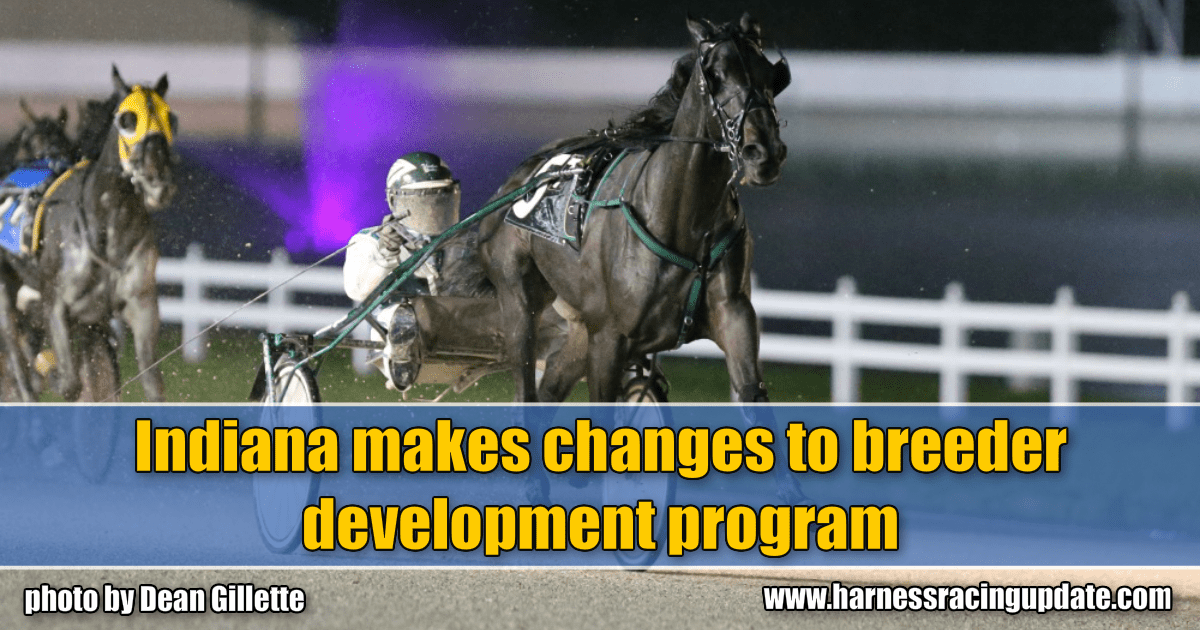

Indiana makes changes to breeder development program
by James Platz
Indiana’s Standardbred Breed Development program closed the books on another successful sires stakes campaign Friday, capped by an action-packed Super Night program. Two days prior, however, members of the Indiana Standardbred Breed Development Advisory Committee and Indiana Standardbred Advisory Board met at Hoosier Park Racing & Casino and approved program changes meant to address the concerns of horsemen. The revised program will result in $700,000 more being pumped into Indiana Sires Stakes, with estimated purses for 2019 reaching $8.5 million. The full breed development program will offer more than $13.6 million in purses and incentives next season.
“Change can either be good or bad. I think this is something that has a lot of support in the industry, and will breathe some new life into the program,” said Jessica Barnes, director of racing and breed development for the Indiana Horse Racing Commission. “It’s going to give horsemen additional opportunities to race in other events and other races, if they choose, without reducing the amount of money available in the sires stakes. I’m excited to see what the impact will be.”
In the current state, horses competing in Indiana Sires Stakes (ISS) battled in five rounds of eliminations and finals, accumulating points in hopes of securing a place in the Super Final. A horse, freshman or sophomore, committed to the program through all five rounds made up to 10 starts before the Super Final in just ISS action alone. The schedule made it difficult to take advantage of opportunities outside the program.
Beginning in 2019, freshman trotters and pacers will forego five rounds of eliminations and finals in favor of six legs leading up to the Super Final, trimming up to four races from the schedule and providing a chance to race in other stakes. Three year olds will see eight rounds of competition, reducing two starts from the schedule.
“Committee members felt like when they were really looking at the program the 2-year-olds were getting a lot of starts and some of those horses weren’t coming back as well as they should. They wanted to lessen the need to race those 2-year-olds so hard. Everybody there felt like eight legs was a good number for 3-year-olds. It would still give them opportunities to compete in other stakes races, other events,” said Barnes. “The Indiana-sired horses have gotten to the point where they are competitive in a lot of other places. We wanted trainers to be able to maximize the earning potential of those horses, not only through sires stakes, but also stakes in Indiana and outside of Indiana.”
Any healthy program adjusts to meet the demands of the time, and committee members realized change was needed to keep it moving in the right direction. Another significant change comes in the structure of the legs and the purses. In the past, breed development funded eliminations using a cap per round and estimating the number of divisions based on entries from previous years. That method resulted in $200,000 in eliminations purses going unpaid when some categories did not see entries on par with the past. Going forward there will be no eliminations, and a set amount will be allocated for each leg in addition to nomination and entry fees. That total amount will then be split by the number of divisions. This will guarantee that all money budgeted is paid.
“If you look at the year 2014, we had 134 divisions and 1,210 entries in our eliminations. By 2018, this past year, we had 96 divisions and 834 entries. There was a decline in the number of entries, the total money that we allocated wasn’t being paid out, and I really think the breed development committee and the advisory board sees this industry as a partnership all the way from the racetracks to breeders, trainers, owners and the people operating the sales,” Barnes said. “I think our program has become tougher, more competitive than it has been in the past. With that said, if we continued the program the way that it is currently structured, I think we would see less and less money being paid out. Therefore, the committee felt like it had to make some adjustments.”
Barnes provided some sample figures based on 2018 statistics. Legs for 3-year-olds going only one division would offer purses of $87,968. Two divisions would result in a per race purse of $48,960 and three divisions would each compete for somewhere in the $35,000 range. Applying 2018 numbers to the freshman program, a single division would offer a purse of $122,500, two divisions would see $66,250 per event and three divisions would compete for purses of $44,833 each.
Another change coming out of the meeting was a 25 per cent bump of the Super Final purse to $250,000. Horses that finish sixth through tenth will continue to receive $4,000 for earning their way into the race.
While the changes will need to be approved by the Indiana Horse Racing Commission, announcing the revised program in advance of next week’s Hoosier Classic sale means buyers know the structure of the program prior to investing. Hoosier Classic sale manager Steve Cross said that benefits all involved.
“That’s the key. You cannot make changes like that after a sale. Buyers have to know what they are racing for,” he said. “I’m not sure what to expect, but I think the announced changes will help. I think doing nothing would have hurt us more.”















